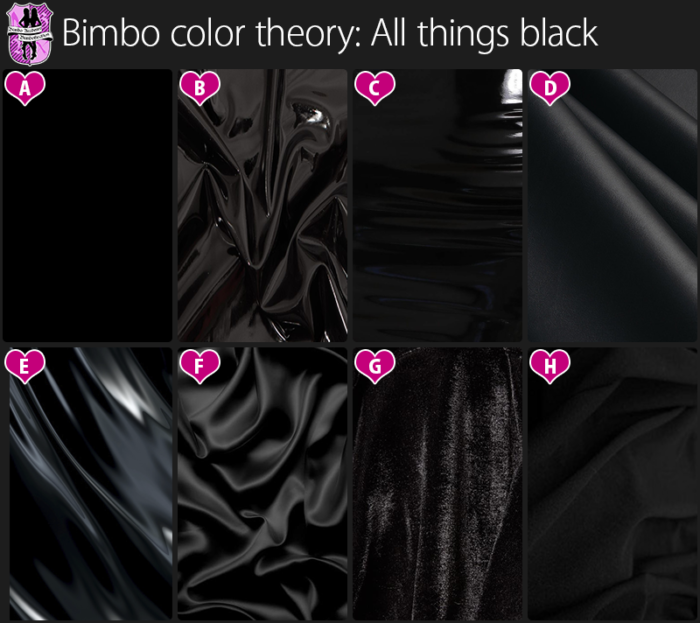I recently announced an analysis about the color white within the scope of our bimbo color theory series in the last post about bimbo brides, where this color is the essential key factor of the whole style. Well, here we are, but we will talk about the direct opposite this time, before we get to the promised talk about the color white in terms of the bimbo color theory: The color black. Even if there isn’t anything more contrary than these two colors, they do have very much in common, which is why we talk about black before we come to its counterpart in the next post of this series.
Black
“I’ve been 40 years discovering that the queen of all colors was black.”
Pure black is the darkest tone we can observe, the complete absence or complete absorption of light (“Vantablack” is in fact the blackest material man is able to produce. It absorbes 99.965% of radiation in the visible spectrum). A color without hue, therefore often not seen as a “real color”. The way this basically works is, an object which is regarded as black by the human eye, does in fact devour incoming light, transforming it into heat, while reflecting none or very little of it to reach the observers retina. Because no color of the visible spectrum is transported to the observer (all of it got absorbed), the object is rendered black, as something visible with the absence of any colors. These physical properties are not the reason for the special role this color has in most cultures all over the world and often the mysterious appeal many people receive from it, but surely add to it:
The color of mourning, loss and death
“When He broke the third seal, I heard the third living creature saying, “Come.” I looked, and behold, a black horse; and he who sat on it had a pair of scales in his hand. And I heard something like a voice in the center of the four living creatures saying, “A quart of wheat for a denarius, and three quarts of barley for a denarius; but do not damage the oil and the wine.””
Black represents the color of mourning and bereavement in most western countries (unlike in some countries and areas in Africa and Asia, where interestingly white is the color or mourning) and is part of a strict dresscode when it comes to funerals and the time to mourn for the passed away. For example, in Victorian England, “non-reflective black paramatta and crape for the first year of deepest mourning, followed by nine months of dullish black silk, heavily trimmed with crape, and then three months when crape was discarded ” (Patricia Jalland, Death in the Victorian Family, p. 300.) was considered as the proper way to deal with a recent death. Even today, in many areas, widows are expected to wear black the rest of their lifes after their husband died, for example in Greece and some areas in the spanish speaking parts of the world. This may result from effects we talk about in the next part of this post, and could be an opportunity for me to write another article about “bimbo widows” (write me in the comments if you want that) later in the future… However, black is the color that will always be connected to tragedies and loss, leading to sayings like “a black day in the history of…” when a sudden disaster strikes humanity. And let us not forget – even Death himself wears black.
The color of evil and the forbidden and hidden aspects
I’m pretty sure you realized most movie villains dress in black, evil armies in the movies bear a black banner, and whenever the devilish mastermind or the fortress or the headquater of the evil forces are shown, everything gets dark, colors are desaturated and black becomes the prime and predominant color in the scene. This is due to a very deep and old legacy we humans carry with us, regarding the color black. In olden times, when fear of witchcraft and -black- magic was widely spread across the old world, all these things got heavily bound to the color black, being the color of the devil and everything that is hidden, defective and vicious – representing a great fear of the occult and secret malignancies, buried in the dark, not visible to the human eye, lurking, waiting and spreading until it was time to break free and devour everything that was good and bright. These feelings might originate from even older times, where humans were in constant danger of being hounded and eaten alive by the beasts of long forgotten times or being attacked and vanquished by other tribes in the darkness of the night. In contrast to feline beings, for example, humans don’t have very good capabilities of seing in the dark, due to a prioritization for other aspects, like a better differentiation between colors. This weakness and incapability could very well be the reason why we have a deep and innate fear of the dark and tend to be alarmed when we think we saw something moving in the shadows: It is a simple mechanism which should increase our survivability and reduce the possibility to get eaten in a shadowy environment or the middle of the night where we couldn’t spot the predator in a proper way before he jumped for the kill. This fear inherited incessantly through the ages, and lets us always feel discomfort in pitch black rooms and associate words like “hidden”, “occult”, “evil”, “mysterious” and “forbidden” with the color black, because it reminds us of areas we can not perceive and understand in a complete manner. This led to combinations like “black site”, “black ops”, “black magic”, “black arts”, “black box”, “black market”, “black hole”, “black project” and many more, all of them describing something that is isolated, hidden and self-contained, without the possibilty to look at it from the outside.
The color of authority
Likewise, Black is the color of authority, dominance, seriousness and wisdom. Many official institutions, powers and authorities have dressed their officials, enforcers and decision makers in black, like many police forces around the world, the US Supreme Court, academics, the clergy, church ambassadors and priests in general and… there are of course the famous SS uniforms in pitch black, designed by Hugo Boss in the Third Reich. Without wonder, these aspects play a very important role in the BDSM subculture, where black is almost the only accepted color for dominant figures, underlining their dominance and authority to exert power. The omnipresence of this color in this subculture led to many submissive participants also wearing black, when esthetic clothes and stylings are needed, about what many dominant masters are not very happy, who instead like their slaves to be completely naked (one of the reasons I’m not too excited about the classic BDSM scene), without equipping them with the color of authority and might.
Black in fashion and bimbo culture
Now we are about to enter the realm of relevance for the bimbo culture: Black plays an important and very unique role in the fashion world. Aside from the aspects of this color we already talked about, letting a girl wearing a black outfit appear mysterious, unapproachable and wicked, black has some other very unique properties: Black clothes let the wearer appear slimmer and her body more defined and more slender than any other color. Because of that it is always a perfect way to emphaszie the body of a bimbo even better with a black dress. This results from the physical behaviour we talked about earlier, with the fabric not reflecting enough light to create areas which are shadowy and areas which are definitive from those, not letting them appear vaulted or curved, so reducing the perceived coves, folds and wrinkles. With that in mind, it is amusing to know, that people tend to estimate a black box of the same volume as a white one to be far heavier. This however, might be a good reason to wear black for a bimbo, because apart from looking slimmer, her tits might look heavier to an observer, which is very welcomed. The next useful property of black clothes is the fact, that black as a color without hue, can be combined with every other color there is! It is very important for a bimbo to make decisions regarding her outfit that lead to a preferably perfect, harmonic, appealing style, without disturbing inconsistencies, unsuitable combinations and untuned aspects. This also true for choice of colors! Complementary colors, clashing tones and biting colors are never an option for a doll! Everything has to play together in a matching, balanced and fine tuned combination, leading to a perfect result! Black can be combined with any color, and will always look good. No matter if it is white, pink, red or leopard print. These are some of the reasons, why black is so highly regarded in the fashion culture. Black dresses are always fitting, always look fashionable and create an appeal of voguish chic, combined with elegance, classiness and mystery. This form of aesthetics render a girl in a sexy, wicked and exciting way, directly communicating to the hidden, prohibited wishes and dreams of every man, sparking his curiosity and his darkest desires. This led to the invention of the “little black dress”, by Coco Chanel (or “LBD”), creating the rule of fashion, that every woman should own a simple, elegant, black dress that can be dressed up or down depending on the occasion. It goes without saying, that every bimbo doll should respect this rule, and get at least one LBD (on which we will have a separate post about), preferably many more. So, when you now hear someone say “XXXX is the new black…” – you now know why black is such an important and everlasting factor in the fashion world and why it is such an important color for bimbo dolls, even if it is far away from the girly, playful and feminine bimbo standard color pink.
The color black and gimbos (the gothic culture)
Of course, with gimbos (goth bimbos) being a well established part on this blog, we have to talk about them and their relation to the color black, black clothes and the gothic culture in general. Everyone knows it, no matter if he or she ever came into contact with the gothic subculture: Goth girls all wear black. It is the only color allowed in this scene. While this isn’t really accurate and therefore not true, it is something that can be reworded to gain more substance: Many goth girls mostly wear black, sometimes combined with another color. But why is that? Black dresses are a trademark of the gothic movement, and in contrast to rapidly changing fashion trends, a core element of the self-publicizing and individualistic concept of the communitisation practice of the black subculture. It all began in the 80s, when a separated youth movement had its schism, and broke loose from the post-punk, independent scene which gave birth to it. A movement that inherited quite some aspects from its predecessors, like rejection of commerce and fugacious trends and a quite derogatory opinion of the establishement. This movement combined its ideals with dresscodes to strengthen the community spirit and to increase the demarcation to the rest of the world, by choosing an invariable color for their outfits, which did express their thoughts and pessimistic attitude towards the world and humanity: The color black was a no brainer for the new born dark wave gothic culture. Dark, pessimistic, deep, arrogant, nihilistic, true and mysterious… the gothic culture always thought of itself as something better than the rest of the world (isn’t that arrogant attitude a part of the allure goth girls and gimbos have? Especially when it fades when she begs for more in the bedroom?) – and this color represents all that. Of course, fashion changed, even in the gothic scene and different styles came and went throughout the years. But black is still the way to go there. Its symbolism, the association to different aspects in the gothic culture, topics like death, gothic literature, horror, evanescence and grief – are still there, but got combined with remarkably sexy stylings, porn worthy clothes, extremely feminine and girly accessories and elegant, erotic and classy outfits. At least since many aspects of the BDSM culture made a transition into the goth scene, black latex, black patent leather, black leather and rubber are an inherent part of the gothic culture, as well as black stockings, black high heeled boots, black corsets and many many things more (you can see this by looking at gimbo rolemodels Dani Divine and Starfucked for example). As I mentioned, many gothic girls tend to combine an overly black outfit with a single, bright color. Something that might well be a remnant of the “cyber industrial intrusion” in the gothic culture in the early 2000s that introduced bright, neon colors to the dark scene, sometimes used by girls as a trademark color for themselves (for example: pitch black short dress, black stockings, black high heeled boots with bright green shoelaces, bright green makeup and bright green accessories). What does this mean for true gimbo girls? Well, stick to your black dresses! What did fit cute goth girls for over 30 years now, still does very well, and even more if you try to be a real scene queen and a true gimbo doll. Go for black, shiny latex, black high heels, black stockings, black ultra short mini skirts, black victorian dresses (with stockings underneath), black corsets, and dark, heavy make up. Go for black tops to cover your silicone enhanced big tits, and try to be the most sexy girl in the club. And not just there… never forget: ALWAYS dress to impress! This rule does apply to goth girls (as all the other bimbo rules do!)! If you do want to combine black with a color (which always works, as we already stated above), try to integrate the bimbo spirit and go for a bright neon pink! This combines the spirit of both worlds in the best way possible (have a look at our style check with gimbo rolemodel Starfucked, where she does exactly that)!
Items for bimbos and gimbos alike
Black (Figure A) – in its universal opportunity for use, is your first address when it comes to latex (Figure C), patent leather (Figure B), rubber and leather (Figure D). There are other colors which do work fine with these kinds of materials, like even pink, but having all those items, like, high heeled, latex overknee boots or some short latex miniskirt, in black is always the first must have before you continue and get the same item in another color. This does even apply to many standard items for bimbo and gimbo girls, like the famous Chanel 2.55 or your first pair of Louboutins. Black does always work for fine underwear (silk (Figure E)), classy dresses (satin (Figure F)), wicked lingerie, fancy gothic dresses (velvet (Figure G)) and plays a big role in certain bimbo costumes, like, for example, the bimbo maid, and can be worn to any occasion on any event.
Now, slip into your little black dress, admire yourself in the mirror, and make sure you have a huge collection of classy, sexy, black lingerie, black high heels and some items made of black latex to please your trainer/master/partner or to be the queen of the night in the nearest goth club. Be that naughty, wicked, little girl!
Discuss this on the academy subreddit!
Support me on Patreon! Every donations helps me to write more and better posts! Thank you very much!
Support me by donating in different crypto currencies, or visit my shop!





I absolutely want to hear about bimbo widows. I would also be interested in bimbo aging, bimbo MILFs, and the bimbo mindset in times of hardship (sickness, economic hardship, etc), as an important way of presenting the bimbo lifestyle as practically accessible and sustainable.